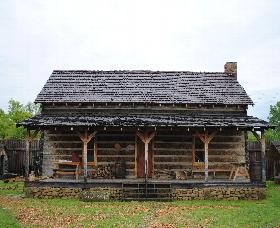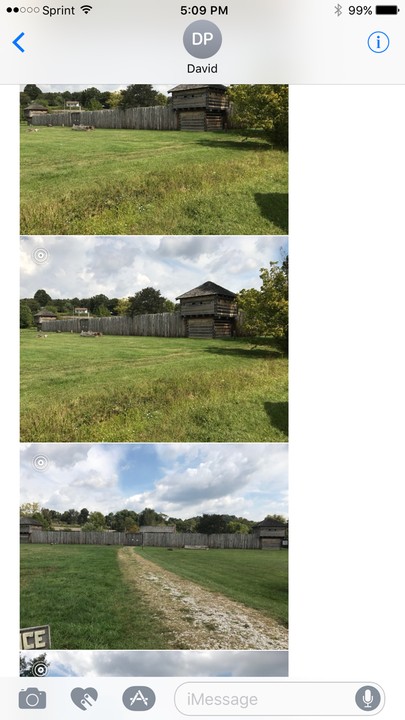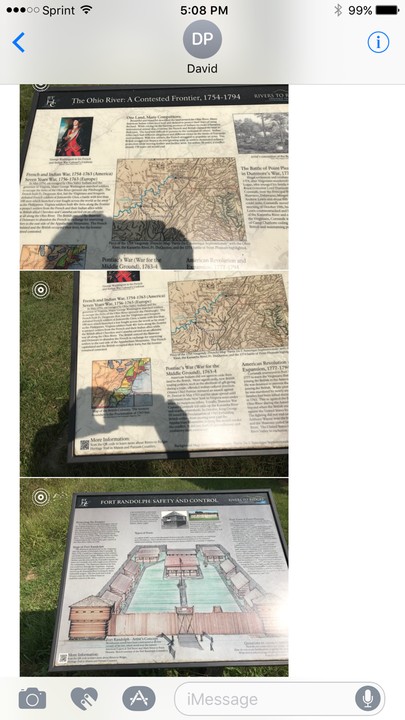Fort Randolph
Introduction
Text-to-speech Audio
Images

This was added to the fort in 1997 being a 1840 hewed log house and was build out side of the fort itself. reconstructed outside the Fort.


Differ views of Fort Randolph

Top picture is information about George Washington looking at the land around what was to be Fort Randolph. Middle picture is information on the Fort itself Bottom pictures is a drawing of the inside of the Fort and the way it is laid out.

Backstory and Context
Text-to-speech Audio
Fort Randolph was important in both the Dunmore War and the American Revolutionary war. For the Dunmore War it was the only major battle with action to happen and in the American Revolutionary War it was the site where Chief Cornstalk and three other members of the Shawnee tribes were killed and cause the siege of Fort Randolph. Folk lore has it that Chief Cornstalk put a curse on the land that is now called Point Pleasant but no one knows if this is true. With both of these being a part of West Virginia history as well as part of American’s history the story can still be seen today with re-enactments a few times a year.
On the banks where the Ohio and Kanawha River meets was the only major battle action of the Dunmore’s War when it was fought on October 10,1774 and it when on to become the place where Fort Randolph was built in May 1776. This place is now called Point Pleasant, West Virginia. This battle was called the Battle of Point Pleasant which was also known as the Battle of Kanawha. This battle was between the Shawnee and Mingo tribes, leaded by Chief Cornstalk, that lived along this area and the Virginia militia, leaded by Colonel Andrew Lewis. The Indians tribes were trying to stop the Virginia militia from coming farer into their land. But after a long and hard fought battle Chief Cornstalk retreated. With a second force lead Lord Dunmore, marching into this Ohio River Valley they had Chief Cornstalk agree to a treaty ending this war.
This fort was build three times with the first being in November 1774 and named Fort Blair after John Blair, a man that had died two days early and was a prominent person in the colony, by Captain William Russell. Captain Russell evacuated the fort in June 1775 from orders from Lord Dunmore. With the fort being destroy after Captain Russell there was no known reason why so were saying that the white man living there burned it and others say that it was the Indians that burn it down. The second name for the fort was Fort Randolph which is the name most know it by. This second fort was built in May of 1776 by Captain Mathew Arbuckle and he named it Fort Randolph for Peyton Randolph who was the First President of the Continental Congress. It was built for a strategic location it was known for years before the American Revolution because of the Treaty of Fort Stanwix of 1768 and even George Washington came by canoe to look at the land to see its importance to the colonists. With the second fort having the same fate as the first after being evacuated in 1779 but this time it was burned by the Indians. The third time it was built probably in 1785 it kept the name Fort Randolph and was used more for the protection of the people living around the area from the Northwest Indian War but was build a little farer up from the other two with Colonel Thomas Lewis was in charge
The importance of Fort Randolph in the American Revolutionary War was that it was built to help with the raids of the Indian along Western Virginia and Pennsylvania along with two other forts in the area called Fort Pitt and Fort Henry. But Fort Randolph was not helping with the raids so the Americans were working on a plan for an offensive expedition into Ohio across the river. But when Chief Cornstalk, hear about this plan he went to the Fort, on a diplomatic trip, to talk to Captain Arbuckle and to tell him that he would not be able to keep all of the tribes that was on this land neutral if they were to go in to Ohio to fight. Captain Arbuckle made the decided to keep Chief Cornstalk and some of the other Shawnees at the fort as hostage thinking this would keep the Shawnees neutral so they would not fight them. On November 10 an American militiaman man was killed outside of the Fort and some of the people that was there force their way into the jail and killed Chief Cornstalk, his son and two other companions. It was at this time that it is said he put a curse on the land that is now known as Point Pleasant. These men were taken to trail by Virginia’s Governor Patrick Henry but was not found guilty because no one would say anything again them. Because of these killings on May 20, 1778 around 200 Wyandot’s and Mingo’s warriors under Dunquat a chief of the Wyandot tribe attacked Fort Randolph for a week siege cutting off all supplies. But even with all of the fighting they were not able to make them surrender do they moved up to Fort Donnally and attacked it. With this and the men needed to fight in another location the fort was abandoned in 1779 and with this the Indians burned it down.
Today a replica of Fort Randolph can been seen in Krodel Park located in Point Pleasant, West Virginia around a mile from the original fort stood in 1977. On October 13, 1974 on the Bicentennial of the Battle of Point Pleasant it was dedication. This first building was about 65 yards wide and 60 yards deep with two log cabins at the rear corners. Three other additions were made in 1997, a trading post within the fort and a log hewed house right outside or the fort. In 1998 two blockhouses were added to the front to corners of the fort. The last being in 1999 when a hewed log Blacksmith shop was added inside the fort. They have major events throughout the year with re-enactments of the siege of Fort Randolph along with a fall harvest and a Christmas in the fort. Check with the Mason County Convention and Visitors Bureau or the Fort Randolph web page for the dates, times and fees for these events.
Cite This Entry
Kellison, Phillip and Kathy Carroll. "Fort Randolph." Clio: Your Guide to History. September 23, 2017. Accessed August 3, 2025. https://theclio.com/entry/609
Sources
Mason County Convention and Visitors Bureau
- Fort Randolph - Point Pleasant, West Virginia - Landmark ...
https://www.facebook
- May 16, 1778: Wyandot and Mingo Indians Attack the Fort Randolph ...
http://wvpublic.org
